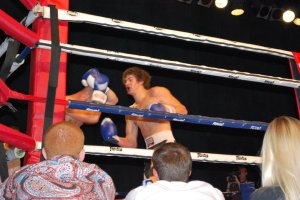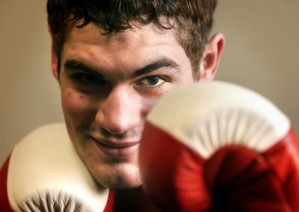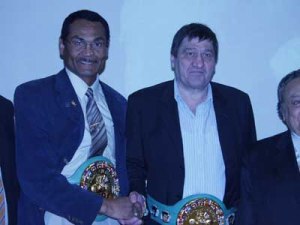By Brian D’Ambrosio
At 24, Adam Axelson feels as if he is in the prime of his life. On the outside, he looks solidly conditioned at 185 pounds, his body his instrument, no more muscle than needed, no less either. His is an anatomy of function. He trains his body to do what he asks, and it performs properly when expected.
He has kickboxed professionally and trained and competed in the mixed martial arts, yet it is the sport of boxing that he finds most alluring, even addicting. The sounds of leather slapping leather. Bell, dings, grunts, and gongs.
“Boxing is in my blood,” says Axelson, a Butte native, who calls Missoula home.
Axelson began boxing in high school, at approximately 16-years-old. Few places outside of Butte have the heritage or character to produce a Montana fighter; it is a city where you expect the desperation of street-toughs with nothing to lose and nowhere to go but up.
“Butte has that reputation of the rough and tumble town,” says Axelson. “But I was raised in the nice area of Butte, and that’s not really an oxymoron. I played golf and snowboarded – those are kind of my sports. But I started to get hungry and started to really want something. I got into a couple of altercations in school, and I wanted to learn how to fight.”
At the time, there was not a single amateur boxing gym in Butte, so Axelson had to drive to Anaconda five days a week to train with boxing instructor Chris Eamon. “That’s what I did from my sophomore to senior years. Around then, they started to open up a few amateur clubs in Butte.”
Axelson was selected as “Best Senior Male Boxer” for 2008 for the Montana Local Boxing Committee of USA Boxing. Subsequently, Axelson, a light heavyweight, said he was also recognized the “Second-Best Pound-for-Pound Male Boxer” in Montana. At 19, he went to the USA National Amateur tournament, utilizing, and competing at, the US Olympic facilities. “I had one good fight against a phenomenal athlete, and he outclassed me pretty significantly. I got my butt beat pretty bad. It was so amazing to compete with athletes of that caliber.”
On July 14, 2012, Axelson boxed his first opponent in Browning, Montana, against John Jay Mount, under what he calls a “very weird set of circumstances.” That card featured Joe “The Boss” Hipp, who returned to the boxing ring in his hometown for the first time in seven years, winning in the fifth round with a TKO against Harry Funmaker. His first fight since 2005, Hipp – the first Native American to compete for a world heavyweight boxing championship – bumped his lifetime record to 44-7 with 30 knockouts.
“(Promoter) Shelley Burton called me on a Saturday morning,” says Axelson. “She starts asking me how much I weighed and if I was ready to go. I took the fight on six hours’ notice. I drove up to Browning, just me and my son, and had a great four-round fight. It was a great unofficial pro fight. John Jay Mount is a real technician in the ring and I have a lot of respect for him. I beat him up pretty bad, opening up cuts all over his face. His eyes were swollen shut. He is a warrior, who kept on coming.”
Bruised, fatigued, and elated, Axelson drove back to Missoula that night with the fresh memory of having his hand raised in victory.
In Axelson’s second fight, he lost a four-round decision to friend and fellow Montanan Leo Bercier. Bercier, a rugged journeyman and Great Falls native, with an overall 8-18-1 record, outpointed Axelson at a bout held during Evel Knievel Days. “Leo is a really good friend, we spar together. But they were willing to pay us and we gave them the best show they could ask for. We were not trying to kill one another. It was a great fight. He came out a little ahead.”
Since the loss to Bercier, Axelson has worked hard to isolate himself, to gather his thoughts, and to regroup emotionally. It was back to sweating, toiling, laboring. It was back to staring at the bare ceiling when doing sit-ups, to laying flat on the cold exercise mat, to hitting the pavement before sunrise for a run, and listening to the squeaky sound of the slippery, freshly mopped gym floor.
Sacrifices have payoffs, and for Axelson, who credits Missoula trainer Matthew Powers with helping him “grow as a fighter,” that payoff comes November 9 in Kalispell, when he makes his pro debut against Joe Broken Rope (2-4-1) of Billings. (Axelson’s two previous fights technically do not count, for they weren’t officially sanctioned by legitimate boxing organizations.)
“He’s slick,” says Axelson as Broken Rope. “He’s been around for a while, and he knows what he’s doing.”
Win, lose, or draw, Axelson intends to fight hard. How far does Axelson hope to advance in boxing’s dangerous world of shiny trunks, body shots and refereed violence?
“At this point, I have a 15-month-old son, I’m getting married, graduating from college, and working on a side business. I’m trying to balance boxing together with all my other priorities. I love boxing. Like I said, it gets in your blood, and you want to remain close to it.”
For more information about the Friday Night Fights card on November 9 in Kalispell, which includes a bout with top ranking WBO heavyweight Chauncy Welliver, visit http://www.facebook.com/BurtonBoxing







